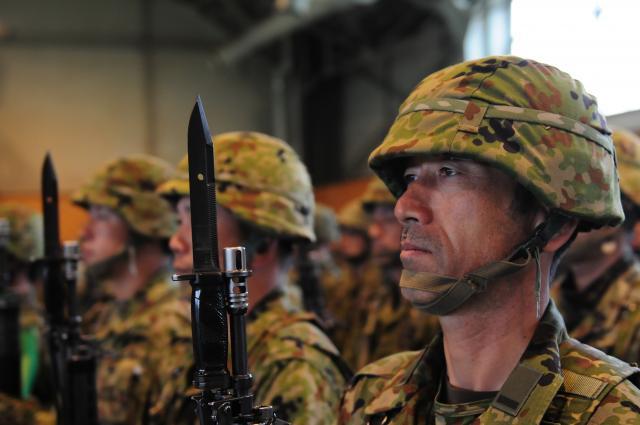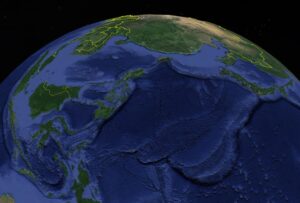Japan Blazes Trail For US Army: Coastal Defense Vs. China
Posted on

Japan Ground Self-Defense Forces soldier.
WASHINGTON: How can we deter — or, in the last resort, defeat — a more assertive China? Air and naval forces may not be enough. While the US Army is ambivalent, the Japanese army may have some lessons for their ground force counterparts in America.
“They’re not standing around waiting for us to do something,” Andrew Krepinevich, head of the Center for Strategic and Budgetary Assessments, told me after his latest trip to Asia. “Japan wanted to do its part in defending the northern sector of the ‘First Island Chain'” — a long arc running from the Japanese home islands down through Taiwan and the Philippines into Indonesia. “They are building a series of facilities along the Ryukyu island chain to discourage Chinese acts of aggression and coercion,” he said. “It was very impressive.”
In particular, the effort by the Japan Ground Self-Defense Force aligns with a concept Krepinevich laid out in in a February Foreign Affairs article on “archipelagic defense.”

Andrew Krepinevich
“Rather than risk sending warships within range of PLA defenses,” Krepinevich wrote, “the United States and its allies could rely on ground forces, based along the first island chain and armed with mobile launchers and anti-ship cruise missiles,” as well as anti-aircraft missiles and missile defenses. In Krepinevich’s concept, Navy ships and long-range Air Force bombers would form a mobile reserve behind the land defenses, reinforcing threatened points and stopping Chinese breakthroughs. The fleet itself, however, would stay on the far side of island chain from China.
In the Western Pacific, Krepinevich told me, “one of the big advantages we have is — unlike many of our other recent military operations, where we’re projecting power — in this case we’re merely trying to defend our allies. It’s the Chinese who have to come out.”
In short, we don’t have to take the war to the enemy or destroy them: We just have to keep them from successfully taking the war to and destroying us. By contrast, advancing US ships and aircraft into easy missile range of the Chinese homeland would be a very expensive way to lose.
That message isn’t easy for the US military to hear. We’ve not had to play defense since the Cold War. Once the Soviet war machine collapsed, the US focused on power projection: aircraft carriers, strike fighters, rapidly deployable ground forces and the like. Going into other people’s airspace, waters, and territory to destroy targets is what we do. The Army in particular, under intense pressure to reinvent itself for the post-Afghanistan era, would rather tout its agile expeditionary forces than its ability to dig in and hold islands.
Digging in and holding islands, however, is hardly counter-cultural for the Japanese armed forces, as veterans of Iwo Jima would attest. Nor is a defensive strategy anathema for Japanese policymakers, whose post-1945 political culture is deeply pacifistic.
In his Foreign Affairs article, Krepinevich had already noted with approval Japanese wargames that put shore-based anti-ship cruise missile units in the Ryukyus. When he visited this summer, he found they had gone farther. “I was invited to visit the commander of the Western Army and his staff,” Krepinevich told me. “He was excited because he believes they are implementing what the article was talking about in terms of ground forces.”
The Japanese are deploying air and missile defense batteries to the islands to protect against Chinese strikes. They are deploying shore-based anti-ship missiles to keep Chinese ships at bay. They are training to lay minefields offshore. And they are working with the US Marine Corps to develop an amphibious brigade that could seize or reinforce embattled islands.
Krepinevich cautioned against relying on amphibious units as a mobile reserve, however. In an “anti-access/area denial” (A2/AD) environment dominated by precision missiles, he said, “it’s going to be difficult to maneuver troops. They’ll be going across no man’s land.”
Instead, he argued, in many cases the best reinforcements may be long-range missiles. The geometry of the Western Pacific is such that if one fortified island is being overwhelmed, other islands along the defense line can fire their long-range weapons in its defense. It’s a massively upscaled version of the machinegun nests whose interlocking fields of fire made First World War trenchlines nigh-unbreakable.

An “archipelagic defense” in the West Pacific (CSBA graphic)
How far can missiles reach? “We’re of course limited by the INF [Intermediate Nuclear Forces] treaty, but we could still go up to over 300 miles — 500 kilometers is the limit,” said Krepinevich. “300 miles gives you a lot of ability to maneuver fires instead of forces, to concentrate fires instead of physically concentrating units and troops, and that can be a way to help protect a threatened point.”
Even with long-range missiles, however, Japan can’t cover the whole threat zone by itself. “The Japanese I spoke to were thinking of a division of labor,” Krepinevich said, “where they took primarily responsibility in the northern sector of the First Island Chain and we took primary responsibility in the southern sector.” While advanced and prosperous US allies like Japan, Korea, and (unofficially) Taiwan can anchor the north end of the line, poorer countries like the Philippines can’t hold the southern end without extensive help from US forces.
The US Army doesn’t have all the weapons systems it needs to execute these tactics, however, particularly anti-ship missiles capable of being launched from shore. But it could buy them from Japan or other allies — if the Army decides it wants them.
Right now, the service is unsure. “The Army’s under a lot of pressure right now as the service that’s being asked to sacrifice the most in the drawdown,” Krepinevich said, and it has obligations not only in the Western Pacific but in the Middle East and in Europe.” While both the House and Senate Armed Services committees want the Army to look into shore-based anti-ship weapons, he went on, “it hasn’t really been directed by senior Pentagon civilian policy-makers to figure out how ground forces can help defend the First Island Chain.”
“Finally, you’re talking about upsetting several dominant subcultures in the Army,” Krepinevich said. “Archipelagic defense is not built around brigade combat teams.” The Japanese are downsizing their conventional ground combat units to free up resources for their new coastal defenses. Given limited budgets, the Army would face the same choice. With the service still struggling to implement the last round of cuts and bracing for another, finding money for anything new is hard.
Subscribe to our newsletter
Promotions, new products and sales. Directly to your inbox.
